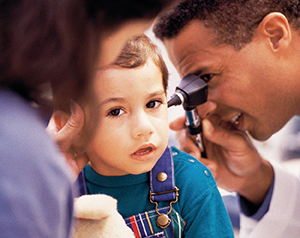Foreign Object in the Ear or Nose
Foreign Object in the Ear or Nose

When to go to the emergency room (ER)
If you can't see or easily grasp the object, call your pediatrician or go to the emergency room. Avoid poking the object with cotton swabs or other tools. This may cause further damage.
What to expect in the ER
The healthcare provider will examine your child's nose or ear using a lighted instrument. A speculum may be used to widen the opening to the ear or nose. Removal of the object will depend on the object and its location. Your child may be asked to expel an object from the nose with hard blowing. To remove an object, your child is given local anesthetic to block pain. Then, the healthcare provider removes the object with a tiny clamp or hook. A gentle stream of water may dislodge an object in the ear. If the object cannot be removed by these means, the healthcare provider may use suction or a small hook. In that case, general anesthesia may be given to your child to help him or her sleep through the procedure.
When to call your child's healthcare provider
Call your healthcare provider if your otherwise healthy child has any of the signs or symptoms below:
Fever (see Fever and children, below)
Redness or swelling
Pain
Pus draining from the nose or ear
Fever and children
Always use a digital thermometer to check your child’s temperature. Never use a mercury thermometer.
For infants and toddlers, be sure to use a rectal thermometer correctly. A rectal thermometer may accidentally poke a hole in (perforate) the rectum. It may also pass on germs from the stool. Always follow the product maker’s directions for proper use. If you don’t feel comfortable taking a rectal temperature, use another method. When you talk to your child’s healthcare provider, tell him or her which method you used to take your child’s temperature.
Here are guidelines for fever temperature. Ear temperatures aren’t accurate before 6 months of age. Don’t take an oral temperature until your child is at least 4 years old.
Infant under 3 months old:
Ask your child’s healthcare provider how you should take the temperature.
Rectal or forehead (temporal artery) temperature of 100.4°F (38°C) or higher, or as directed by the provider
Armpit temperature of 99°F (37.2°C) or higher, or as directed by the provider
Child age 3 to 36 months:
Rectal, forehead (temporal artery), or ear temperature of 102°F (38.9°C) or higher, or as directed by the provider
Armpit temperature of 101°F (38.3°C) or higher, or as directed by the provider
Child of any age:
Repeated temperature of 104°F (40°C) or higher, or as directed by the provider
Fever that lasts more than 24 hours in a child under 2 years old. Or a fever that lasts for 3 days in a child 2 years or older.
Updated:
March 21, 2017
Sources:
Diagnosis and management of foreign bodies of the outer ear. UpToDate, Diagnosis and management of intranasal foreign bodies. UpToDate
Reviewed By:
Fetterman, Anne, RN, BSN,Kacker, Ashutosh, MD,Turley, Ray, BSN, MSN